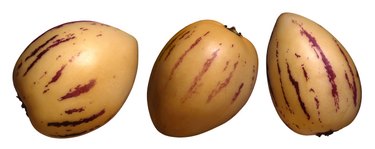
Pepino melon is native to the Andean region of South America. The fruits are cucumber-like in flavor, refreshing, juicy and sweet. They are not commercially imported to the United States but are cultivated widely in New Zealand, Australia and Chile. The plant is a warm season fruit but can survive small periods of temperatures down to 28 degrees Fahrenheit. The plants are quite small compared to most melons and can be grown in a container.
Description
Video of the Day
Pepino melons are attractive fruits that come in a variety of shapes. The melons may be long, round, oval or even heart shaped. Most varieties are seeded but some may be seedless. The plant is herbaceous until it matures, when the stems turn woody. Pepino is in the Solanaceae genus, a member of the nightshade family. These include eggplants, tomatoes and potatoes. The flowers on pepino plants are very similar to potato flowers. Fruits are ready for harvest anywhere from 30 to 80 days after pollination and may be 2 to 6 inches long, yellow or purplish-green with stripes.
Video of the Day
Location
Pepino melons can be grown in sun or partial shade but the best production will occur in full sun. Pepinos need well drained soil with plenty of organic matter incorporated. The soil pH should be neutral, ranging from 6.5 to 7.5. Pepino melon doesn't do well with competition and weed suppression is essential. A good mulch will help prevent competing vegetation. Pepino melons can withstand light freezes but it is best to situate the plants in a sheltered area for sustained cold snaps.
Requirements
Pepino melons are filled with juice and require copious amounts of irrigation to form the fruit. The plants are sensitive to water stress and should not be allowed to dry out. In production cultivation the plants are grown in furrows to preserve water. Pepinos can be fertilized with a tomato fertilizer in the same amounts and manner as this cousin. You can train the pepino to a trellis if you wish but under ordinary conditions it requires no pruning to form new growth.
Propagation
Pepino melons grow easily from seed provided you have a long growing season. They begin to flower four or five months after sowing which means starts or cuttings are a better choice for most areas of the United States. Cuttings can root in less than 14 days. Pepino melons are perennial but productivity diminishes in the second year. Taking cuttings is an excellent way to extend harvest into successive years. Take cuttings after the harvest when the plant is not actively growing.